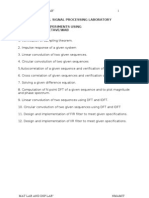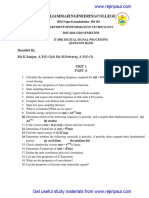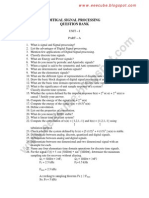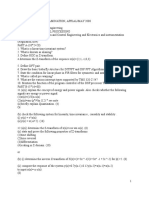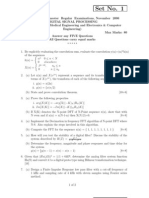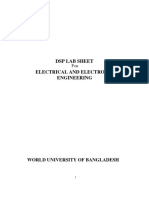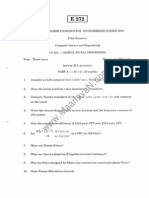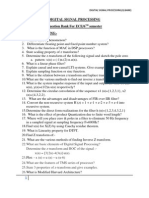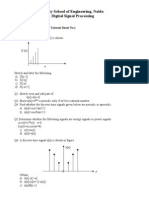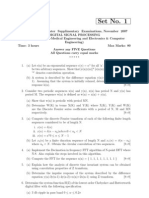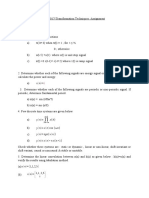DSP Tutorial 2
Uploaded by
pranavenDSP Tutorial 2
Uploaded by
pranavenDSP TUTORIAL 2
1. Using the definition of Z-transform derive the Z transform of the below given signal.
𝑥(𝑛) = 𝑎𝑛 𝑢(𝑛)
2. A first-order digital filter is described by the system function:
𝑎+𝑎𝑧 −1
𝐻 (𝑧) = Assume a = ½.
1−𝑎𝑧 −1
Determine the impulse response h[n] of the above digital filter H(z). y[-1] = 0 Plot
h[n] for the first five samples.
3. Determine, using bilinear transformation method, the transfer function and difference
equation for the digital equivalent of the RC filter. The normalized transfer function for
the RC filter is
5
𝐻(𝑠) =
𝑠+2
Assume a sampling frequency of 150Hz and a cut-off frequency of 30Hz.
4. Using Impulse invariant method design a digital IIR filter for the below given
analogue transfer function.
1
𝐻(𝑠) =
(𝑠 2 + 6𝑠 + 8)
5. The following difference equation describes a digital system. Answer the following
questions.
𝑦(𝑛) = 𝑥(𝑛) − 0.5𝑥(𝑛 − 1) + 0.6𝑦(𝑛 − 1)
a. Find the transfer function H(z)
b. Draw the pole zero diagram in the Z-plane
c. Is the system stable?
6. Convert below given transfer function into its difference equation.
𝑧2 − 1
𝐻(𝑧) = 2
𝑧 + 1.3𝑧 + 0.36
7. Assume a DSP system with a sampling time interval of 125 microseconds, convert
each of the following analogue signal’s x(t) to the digital signal x(n).
𝑥(𝑡) = 10 ∗ 𝑒 −5000𝑡 ∗ 𝑢(𝑡)
𝑥(𝑡) = 10 ∗ sin(2000 ∗ 𝛱 ∗ 𝑡) 𝑢(𝑡)
8. Prove that the magnitude of DTFT for the signal
0 , 𝑛<0
𝑥(𝑛) = { 𝑛
𝑎 𝑛 ≥ 0 , ⎸𝑎 ⎸ < 1 ⎸
is shown from the following expression.
1
⎸𝑋(𝜃) ⎸ =
√1 − 2𝑎𝑐𝑜𝑠𝜃 + 𝑎2
You might also like
- EC60085-DSP and Its Applications Homework-2: Due Date: 14 Sept. 2019No ratings yetEC60085-DSP and Its Applications Homework-2: Due Date: 14 Sept. 20192 pages
- St. Joseph'S College of Engineering Department of Ece Multiple Choice Questions (MCQ) Subject: Ec 8553-Discrete Time Signal Processing (Unit I)No ratings yetSt. Joseph'S College of Engineering Department of Ece Multiple Choice Questions (MCQ) Subject: Ec 8553-Discrete Time Signal Processing (Unit I)65 pages
- Question Bank For Digital Signal ProcessingNo ratings yetQuestion Bank For Digital Signal Processing11 pages
- Discrete-Time Signals and Systems: Gao Xinbo School of E.E., Xidian UnivNo ratings yetDiscrete-Time Signals and Systems: Gao Xinbo School of E.E., Xidian Univ40 pages
- Biosignal Processing - digital systems realizationNo ratings yetBiosignal Processing - digital systems realization34 pages
- Instructions:: Gujarat Technological UniversityNo ratings yetInstructions:: Gujarat Technological University3 pages
- Problem Set No. 6: Sabancı University Faculty of Engineering and Natural Sciences Ens 211 - SignalsNo ratings yetProblem Set No. 6: Sabancı University Faculty of Engineering and Natural Sciences Ens 211 - Signals6 pages
- CS331 Digital Signal Processing Nov Dec 2003No ratings yetCS331 Digital Signal Processing Nov Dec 20033 pages
- 2022 Set B PYQ Paper - Digital Signal Processing PYQ Paper For Sem V Uploaded by Navdeep Raghav (DU Academic Corner)No ratings yet2022 Set B PYQ Paper - Digital Signal Processing PYQ Paper For Sem V Uploaded by Navdeep Raghav (DU Academic Corner)4 pages
- Lab 2 DSP. Linear Time-Invariant SystemNo ratings yetLab 2 DSP. Linear Time-Invariant System15 pages
- Assignment - ITE1017 - Transformation TechniquesNo ratings yetAssignment - ITE1017 - Transformation Techniques2 pages
- Student Solutions Manual to Accompany Economic Dynamics in Discrete Time, secondeditionFrom EverandStudent Solutions Manual to Accompany Economic Dynamics in Discrete Time, secondedition4.5/5 (2)
- Fundamentals of Electronics 3: Discrete-time Signals and Systems, and Quantized Level SystemsFrom EverandFundamentals of Electronics 3: Discrete-time Signals and Systems, and Quantized Level SystemsNo ratings yet
- Digital Signal and Image Processing using MATLAB, Volume 3: Advances and Applications, The Stochastic CaseFrom EverandDigital Signal and Image Processing using MATLAB, Volume 3: Advances and Applications, The Stochastic Case3/5 (1)
- Nonlinear Control Feedback Linearization Sliding Mode ControlFrom EverandNonlinear Control Feedback Linearization Sliding Mode ControlNo ratings yet








